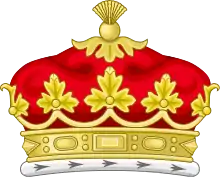Peerage of Scotland
The Peerage of Scotland (Scottish Gaelic: Moraireachd na h-Alba; Scots: Peerage o Scotland) is one of the five divisions of peerages in the United Kingdom and for those peers created by the King of Scots before 1707. Following that year's Treaty of Union, the Kingdom of Scots and the Kingdom of England were combined under the name of Great Britain, and a new Peerage of Great Britain was introduced in which subsequent titles were created.
 |
| Part of a series on |
| Peerages in the United Kingdom |
|---|
| House of Lords |
Scottish Peers were entitled to sit in the ancient Parliament of Scotland. After the Union, the Peers of the old Parliament of Scotland elected 16 representative peers to sit in the House of Lords at Westminster. The Peerage Act 1963 granted all Scottish Peers the right to sit in the House of Lords, but this automatic right was revoked, as for all hereditary peerages (except those of the incumbent Earl Marshal and Lord Great Chamberlain), when the House of Lords Act 1999 received the Royal Assent.
Unlike most peerages, many Scottish titles have been granted with remainder to pass via female offspring (thus an Italian family has succeeded to and presently holds the earldom of Newburgh[1]), and in the case of daughters only, these titles devolve to the eldest daughter rather than falling into abeyance (as is the case with ancient English baronies by writ of summons). Unlike other British peerage titles, Scots law permits peerages to be inherited by or through a person who was not legitimate at birth, but was subsequently legitimised by their parents marrying later.[2][3]
The ranks of the Scottish Peerage are, in ascending order: Lord of Parliament, Viscount, Earl, Marquess and Duke. Scottish Viscounts differ from those of the other Peerages (of England, Great Britain, Ireland and the United Kingdom) by using the style of in their title, as in Viscount of Oxfuird. Though this is the theoretical form, most Viscounts drop the "of". The Viscount of Arbuthnott and to a lesser extent the Viscount of Oxfuird still use "of".
Scottish Barons rank below Lords of Parliament, and although considered noble, their titles are incorporeal hereditaments. At one time feudal barons did sit in parliament. However, they are considered minor barons and not peers because their titles can be hereditary, or bought and sold.
In the following table of the Peerage of Scotland as it currently stands, each peer's highest ranking title in the other peerages (if any) are also listed. Those peers who are known by a higher title in one of the other peerages are listed in italics.
Dukes
- Subsidiary title.
- Holds a second dukedom in the Peerage of Scotland.
| Shield | Title | Creation | Other Dukedom or higher titles | Title used in the House of Lords | Monarch |
|---|---|---|---|---|---|
| The Duke of Rothesay | 1398 | Since 1603, usually Prince of Wales as the heir to the throne Duke of Cornwall in the Peerage of England. |
King Robert III | ||
| The Duke of Hamilton | 12 September 1643 | Duke of Brandon in the Peerage of Great Britain | Duke of Brandon | King Charles I | |
| The Duke of Buccleuch | 20 April 1663 | Duke of Queensberry in the Peerage of Scotland | Earl of Doncaster | King Charles II | |
| The Duke of Lennox | 1675 | Duke of Richmond in the Peerage of England; Duke of Gordon in the Peerage of the United Kingdom. |
|||
| The Duke of Queensberry | 3 February 1684 | Duke of Buccleuch in the Peerage of Scotland | |||
| The Duke of Argyll | 23 June 1701 | Baron Sundridge Baron Hamilton Duke of Argyll (Peerage of the United Kingdom) |
King William III and II | ||
| The Duke of Atholl | 1703 | Queen Anne | |||
| The Duke of Montrose | 1707 | Earl Graham | |||
| The Duke of Roxburghe | 1707 | Earl Innes | |||
Marquesses
| Shield | Title | Creation | Other Marquessate or higher titles | Monarch |
|---|---|---|---|---|
| The Marquess of Huntly | 1599 | King James VI and I | ||
| The Marquess of Queensberry | 1682 | King Charles II | ||
| The Marquess of Tweeddale | 1694 | King William III and II | ||
| The Marquess of Lothian | 1701 | |||
Earls and countesses
- Subsidiary title.
- Holds a second earldom in the Peerage of Scotland.
Viscounts
- Subsidiary title.
| Shield | Title | Creation | Other Earldom or higher titles | Monarch |
|---|---|---|---|---|
| The Viscount Falkland | 1620 | King James VI and I | ||
| The Viscount of Stormont | 1621 | Earl of Mansfield in the Peerage of Great Britain | ||
| The Viscount of Arbuthnott | 1641 | King Charles I | ||
| The Viscount of Oxfuird | 1651 | King Charles II | ||
Lords of Parliament
- Subsidiary title.
See also
References
- "Representative Peers of Scotland". The Scottish Review. 25: 357. 1895.
- "LEGITIMATION (SCOTLAND) BILL [H.L.]". Parliamentary Debates (Hansard). 5 December 1967.
- Lauderdale Peerage Claim, House of Lords, 1884–1885
